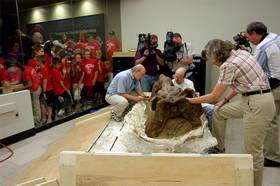High-Tech X-Ray Equipment to Examine Dinosaur Skull

As NASA charts a bold new course into the future, the space agency is briefly taking a step back in time to examine a dinosaur skull.
NASA scientists are using equipment at the Marshall Space Flight Center in Huntsville, Ala., to scan the skull of a Tyrannosaurus rex. The state-of-the-art equipment was originally designed to examine rocket motor assemblies and turbine blades. Discovered on a South Dakota ranch in 1992, it is believed to be the most complete and well-preserved T-rex skull ever discovered.
Discoverers dubbed the find "Samson," recognizing the beast's reputation as the strongest dinosaur to roam the Earth during the late Cretaceous period. "Marshall is one of the few places in the world with the technology needed for such a complex scan," said Dr. Chris Beard, curator of vertebrate paleontology at the Carnegie Museum of Natural History in Pittsburgh. "We are very excited NASA has agreed to provide space-age technology for this project."
Dr. Ron Beshears is leading the project at the National Center for Advanced Manufacturing located at the Marshall Center. Beshears' laboratory team is running various tests on the skull with a high-tech computed tomography scanner used for nondestructive testing of parts and equipment destined for space. The scans provide Carnegie Museum experts with detailed cross-section images of the skull. Such detail will help museum experts better understand the basic anatomy and lifestyle of the T-rex.
"The idea of working with 65 million year old dinosaur bones alongside next-generation space technologies is something we're quite excited about," Beshears said. "We're happy we can use our facility to assist in a scientific investigation of the dinosaur fossil."
The fossil arrived at Marshall Dec. 1, and tests will continue for several weeks. Carnegie Museum researchers will use results to compare Samson's skull with previous computed tomography scans of less well-preserved T-rex fossils, establishing a baseline to determine anomalies in future finds. Although privately owned, Samson is being prepared and studied by the museum for two-years. The dinosaur arrived at the Carnegie in May 2004.
The skull, separated from its skeleton by the museum for study, is largely encrusted in rock. It arrived at Marshall enclosed in a shipping crate approximately 5 feet by 3.5 feet and weighing approximately 1,600 pounds. Because of the skull's fragility, it will not be removed from the crate while tests are performed. After tests and examinations are completed, it will be returned to the Carnegie to recreate the once-fearsome predator.
Source: NASA















